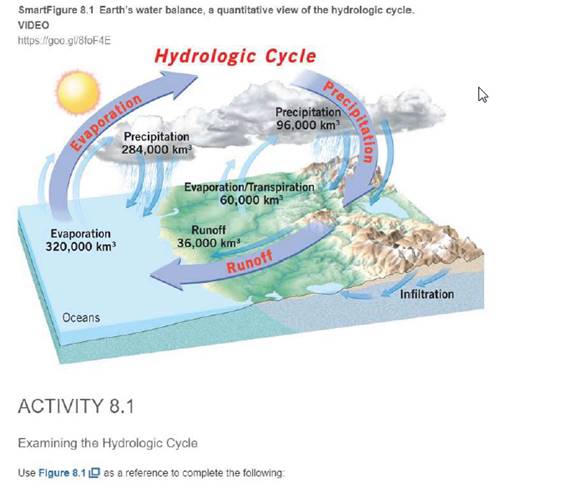
Sketch, label, and discuss the hydrologic cycle.
Earth's water is constantly moving between Earth's surface and atmosphere. The hydrologic cycle describes the continuous movement of water from the oceans to the atmosphere, from the atmosphere to the land, and from the land back to the sea Over most of Earth, the Quantity of precipitation that falls on the land must eventually be accounted for by the sum total of evaporation, transpiration (the release water vapor by vegetation), runoff, and infiltration
A portion of the precipitation that falls on land will soak into the ground through a process called infiltration. If the rate of rainfall exceeds the ability of the surface to absorb it, the additional water flows over the surface and becomes runoff. Runoff initially flows in broad sheets that form tiny channels called rills The rills merge to form gullies, which eventually join to create streams erosion by both groundwater and running water wears down the land and shapes Earth's surface
Figure 8.1 illustrates Earth's water balance, a quantitative view of the hydrologic cycle The figure Implies a globally uniform exchange of water between Earth's atmosphere and surface, but factors such as climate, steepness of slope, surface materials, vegetation, and degree of urbanization produce local variations

Notice in Figure 8.1 that more water evaporates from the oceans than is returned directly by precipitation. If sea level is not dropping, identify a source of water for the oceans in addition to precipitation.
Trending nowThis is a popular solution!
Learn your wayIncludes step-by-step video

Chapter 8 Solutions
Masteringgeology With Pearson Etext -- Valuepack Access Card -- For Applications And Investigations In Earth Science
Additional Science Textbook Solutions
Biology: Life on Earth (11th Edition)
Campbell Biology (11th Edition)
Anatomy & Physiology (6th Edition)
Microbiology: An Introduction
Microbiology with Diseases by Body System (5th Edition)
Physics for Scientists and Engineers: A Strategic Approach, Vol. 1 (Chs 1-21) (4th Edition)
- Connecticut is the only state in America where treated industrial and municipal wastewater cannot be discharged to a surface water body used downstream as a source of drinking water. It is legal in all 49 other states. For example, New Orleans, Louisiana takes its drinking water from the Mississippi River which receives discharges of many, many treated municipal and industrial wastewater discharges as well as agricultural runoff from the more than 20 states that are upstream of it. Should other states be required to adopt Connecticut's standard? Whyarrow_forwardWhat is thermal pollution? How can it be controlled?arrow_forwardhow can the addition of nutrients such as nitrates and phosphates result in a reduction of the amount of dissolved oxygen in the water?arrow_forward
- Congratulations! You have just been selected to be the ruler of China with absolute power! What are the first five things that you would do to protect the environment and human health from water pollution (not other types of pollution)?arrow_forwardWhy is storm water management more of a problem in an urban area than in a rural area?arrow_forwardwhat is biochemical oxygen demand? how is it related to water quality?arrow_forward
- How are most industrial wastes disposed of? How has this changed over the past 25 years?arrow_forwardThink about natural resource management topics. Which topic or topics, are most interesting?arrow_forwardThink about natural resource management topics. Which topic or topics, if any, are of most interest to you?arrow_forward
 Applications and Investigations in Earth Science ...Earth ScienceISBN:9780134746241Author:Edward J. Tarbuck, Frederick K. Lutgens, Dennis G. TasaPublisher:PEARSON
Applications and Investigations in Earth Science ...Earth ScienceISBN:9780134746241Author:Edward J. Tarbuck, Frederick K. Lutgens, Dennis G. TasaPublisher:PEARSON Exercises for Weather & Climate (9th Edition)Earth ScienceISBN:9780134041360Author:Greg CarbonePublisher:PEARSON
Exercises for Weather & Climate (9th Edition)Earth ScienceISBN:9780134041360Author:Greg CarbonePublisher:PEARSON Environmental ScienceEarth ScienceISBN:9781260153125Author:William P Cunningham Prof., Mary Ann Cunningham ProfessorPublisher:McGraw-Hill Education
Environmental ScienceEarth ScienceISBN:9781260153125Author:William P Cunningham Prof., Mary Ann Cunningham ProfessorPublisher:McGraw-Hill Education Earth Science (15th Edition)Earth ScienceISBN:9780134543536Author:Edward J. Tarbuck, Frederick K. Lutgens, Dennis G. TasaPublisher:PEARSON
Earth Science (15th Edition)Earth ScienceISBN:9780134543536Author:Edward J. Tarbuck, Frederick K. Lutgens, Dennis G. TasaPublisher:PEARSON Environmental Science (MindTap Course List)Earth ScienceISBN:9781337569613Author:G. Tyler Miller, Scott SpoolmanPublisher:Cengage Learning
Environmental Science (MindTap Course List)Earth ScienceISBN:9781337569613Author:G. Tyler Miller, Scott SpoolmanPublisher:Cengage Learning Physical GeologyEarth ScienceISBN:9781259916823Author:Plummer, Charles C., CARLSON, Diane H., Hammersley, LisaPublisher:Mcgraw-hill Education,
Physical GeologyEarth ScienceISBN:9781259916823Author:Plummer, Charles C., CARLSON, Diane H., Hammersley, LisaPublisher:Mcgraw-hill Education,





